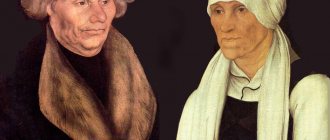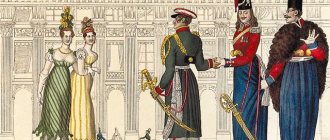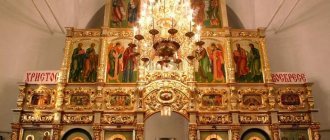Modern holy fools live in almost all major Russian cities
Archive NEWSru.com
It is known that in Rus' at least 10 holy fools were canonized in the 14th-16th centuries alone Archive NEWSru.com
You probably won’t learn about modern holy fools either from a guide accompanying a tourist group or from a glossy guidebook... However, there are still holy fools in our country. Moreover, some of them not only live well, but also prosper. If previously madmen, as a rule, predicted the coming of the Antichrist and the birth of people with dog heads, now they wander through cities and villages, paint the faces of saints, give lectures on the international situation, and sometimes write songs for famous musicians.
What is known about the people from whose midst many revered saints emerged? It is known that in Rus' at least 10 holy fools were canonized in the 14th-16th centuries alone. Let us at least remember Vaska Nagogo, who, according to legend, denounced Ivan the Terrible and predicted the capture of Kazan. When the blessed one died, the metropolitan himself performed his funeral service. In his honor, popular rumor renamed the Intercession Cathedral on Red Square into St. Basil's Cathedral.
But the blessed are a very heterogeneous social group. Among them there are “philistines” and “artists”, “politicians” and even “businessmen”.
Today the Versiya newspaper tried to figure out who they are - these blessed ones, kaliki, eccentrics and fools who gave the cities a special “Old Russian” charm.
Sema the book lover found printed materials at the city dump
So, there was once such an old man - Pinya. He acted as a fool mainly on the streets of Samara, although he wandered as far as Kazan and Moscow. Pinya was once a talented jeweler, then he went crazy and went traveling with a homemade canvas bag. One obsessive thought lingered in his head: that he, Pinya, was a goldsmith. For more than half a century, roaming the streets of cities, the holy fool collected pebbles and put them in his bag and pockets. Sometimes the stones fell apart - then the former jeweler cried with grief. Having collected enough “goods”, Pinya laid out the “jewels” on a rag and began to trade. Bent over, with a sad nose and a bird's head, he waved his arms, caught imaginary customers by the floor and whispered something convincingly under his breath. And even now you can hear from Samarans: “You are behaving like Pinya!”
Blessed Lipetsk Sema the book lover was no stranger to the spirit of commerce. He found printed materials at the city dump. The room that Syoma shared with his mother was littered with books and magazines. He carefully washed and dried some and prepared them for sale. He could “trade” in front of city schools for days on end, shifting his blurry books and enduring ridicule and kicks from high school students. Sima was injured by his alcoholic father as a child - he damaged the boy's spine - so that he walked sideways, and a hump grew on his back.
It should be noted that not every holy fool businessman is pathetic and defenseless. For example, Penza taxi driver Voldemar made a very successful living. In the evenings, the holy fool would lie in wait for late-arriving citizens and force them to ride a broom with him for several blocks. Having taken him to his destination, Voldemar never forgot to demand payment from the exhausted women for travel.
The blessed Saratov wrote songs for Alena Apina
A distinctive feature of modern holy fools is their passion for dressing up. Thus, Volgograd fools Andryusha and Seryozha are a gifted generation of city eccentric artists. The boys wear law enforcement and soldier uniforms. The benefit of this goodness is in abundance in Russian families and they are willing to share it with the poor. Mummers perform antics on the central streets of the city, either depicting battle scenes from the life of samurai, or performing homemade songs. For example, when begging for alms, they whistle on an empty beer can: “Give for us, give for you, and for the special forces, and for Hamas, and for Gorgaz, and for KamAZ, and for the frost, and for Davos!” And they are given it.
One of the most talented blessed people of our time should be recognized as the well-known Saratov poet Yura Druzhkov, the author of all the hit songs of the Combination group. Thanks to his texts, Alena Apina and others like her rose to the heights of fame and prosperity. Yura wrote poems with multi-colored felt-tip pens on scraps of paper, carefully drawing out curlicues. It was with pleasure that I gave verses to those who met me and those who crossed me. He did not receive a penny for his songs; he wandered the streets of his native Saratov in disarray, for which he was beaten more than once. A month ago, Yura was found stabbed to death in his own apartment.
King Apricot talks about a supernova explosion
Russian foolishness has always been highly politicized. The blessed one could say to the face of the boyars and tsars something for which an ordinary person would have his head screwed off. For example, it is known from history that one of the Moscow holy fools, Ivan the Great Kolpak, incited the people against Tsar Boris Godunov. Madmen boldly pointed out the sins of the nobility and predicted political changes. The prophecies of holy fools in the old days were valued more than the current forecasts of German Gref.
In the same Penza, in one of the pubs you can hear the loud voice of a decently dressed man in a hat and tie. The “King of Political Science,” a blessed man with the strange nickname Apricot, gives a beer lecture to visitors about the international situation, rogue oligarchs, the confrontation between Western and Eastern civilizations, and the explosion of a supernova in the center of the Universe. For a variety of knowledge, the lecturer is awarded a “foam”. Despite the broad theme of his speeches, the abundance of quotes, versions and counter-versions, Apricot ends his speeches equally sadly: “Stupid Russia, fucking country!”
And, of course, politically concerned crazy people can be found at any more or less significant meeting, regardless of the color of the banners that are raised there.
The foolish Natalya dreams of marrying a colonel
Among the blessed there are also their own, so to speak, “philistines” - people who do not strive for a political or artistic career, or for wealth. This includes, for example, Lida Kazanskaya. In her youth, she was a model, considered herself to be among the cultural elite, and wore a fashionable Parisian coat with a muff. What happened to her is unknown, but the lady quickly became poor and went crazy. With her hands covered with scabs, she proudly strides along the pavement - in her unchanged Parisian coat, which has long since turned into rags. And everything is muttering in French. The aristocracy does not allow her to beg. She does not take the clothes that people give her out of pity. Disdainful.
Another famous city madman is Tyumen Lesha the bathhouse attendant. He is in excellent health and returns home from the bathhouse in wet clothes in any weather. Lesha hates it when people touch him - he frantically rubs the “stained” area with a washcloth. Jokers often take advantage of this: they casually touch a madman, forcing him to scrub himself in a soap bar for hours. Lesha is most afraid of rats. The city punks are tailing him, bawling: “Lekha, a rat got into your pants!” The holy fool spins around, hits himself on the thighs and shakes his finger at the hooligans.
Other holy fools seek family happiness in their own way. So, in the area of the Volgograd factory “Aora” you can meet a girl of gigantic height, a real grenadier in a skirt, who throws herself at unfamiliar men with joyful screams. Red-haired Natalya squeezes passers-by in her steel embrace, which is not easy to free herself from. The fact is that Natalya dreams of marrying a colonel and is persistently looking for her betrothed. However, in all other respects she is a completely harmless girl.
The wanderer Martha wanted to go around all the famous holy places of Russia
Finally, the most numerous category of Russian blessed are the directly wretched, that is, eternal pilgrims, cliques and madmen near the temple. This is, for example, the pilgrim Marfa the photographer, whom the Versiya correspondent managed to meet in Saratov. Martha collects memorial notes from parishioners and distributes them to famous monasteries. In some villages she is considered almost a saint: mothers think that if this holy fool caresses a child in a cradle, he will certainly recover.
Martha gave the impression of an ordinary grandmother, but she did not look directly, but from the side, tilting her head to the side. Her feet were completely black and bare in the cold.
— I go to holy monasteries. “I was in the Kyiv Lavra, in the Optina Hermitage, in Diveevo,” the wanderer intoned. “I walk without food, sometimes I eat potatoes from the gardens, sunflowers by the road. And I drink water from marsh, lake and herbal dew. The cross must be lowered into the puddle and crossed three times, with prayer, then there will be no loss to health. I walk with a staff and sing the Jesus Prayer.
If in the villages they are not invited into the house, the wanderer spends the night in bathhouses or in haystacks, or even right in the field. Martha also has a goal: she hopes to go around all the famous holy places in Russia and photograph some kind of miracle in each. She found her device, a cheap soap dish, broken on the sidewalk and does not suspect that it at least needs film. Her friend, pilgrim Alexey, wanders with her. “He and I went to Sarov together,” the blessed one readily said. “He bathes in anthills, but he eats like crazy!” He grabs a roll and, holding it in his teeth, plucks and marks the whole roll, and what’s in his mouth is food. He is a “Jerusalemite” and carries with him slivers from the Holy Sepulcher and pieces from the ladder that Jacob saw in his dream. He also has vials, he shows them to everyone and assures that there is Egyptian Darkness there. Completely touched."
Once the holy fool was beaten and the homeless wanted to rob her, but they found nothing in her knapsack except funeral notes.
But last year Tver lost its most beloved holy fool - Stepanych, whom many called the symbol of this city. At night the blessed one huddled in the gatehouse of the Church of the Intercession of the Virgin Mary, and during the day he drew with chalk on the asphalt, on the embankment of the Tmaka River. He painted colorful temples and faces of saints. People who knew him spoke of him as a touching and defenseless person; they believed that this grandfather was not a simple beggar, but a saint. At the same time, Stepanych was repeatedly attacked by aggressive teenagers who beat the old man and took away money and crayons given by people.
When people approached Stepanych and admired his drawings, he blossomed. He said: “Look how the churches are burning, people like it! I treat everyone well, I don’t divide by faith, for me there are neither Muslims nor Jews, because God is one...” Clergymen and city officials came to talk with the blessed one.
Last summer, the artist was beaten and stabbed to death by tramps. Thus Tver lost its blessed one. The poor man was buried with money collected by the parishioners of the Intercession Church.
Most of the holy fools - all these “traffic cops”, “taxi drivers” and “book lovers” - leave quietly, as if to nowhere, and people don’t even notice it. After all, as popular wisdom says: Rus' has fools in reserve for the next 100 years.
Nicola Salos
In 1570, the troops of Ivan the Terrible approached the gates of Pskov. A dirty little ragamuffin came out to meet the king. “Eat, Ivanushka,” he said, handing the cruel ruler a piece of raw meat. Oddly enough, the tyrant did not touch the insolent man - he calmly refused the “treat”, citing fasting. And then the ragamuffin uttered a phrase that became legendary: “You don’t eat meat, but you drink human blood!”
Nikola Salos (on the right is a fragment of a painting by Andrei Ryabushkin)
That man's name was Nikola Salos. In 1570, he saved thousands of Pskov residents from certain death. The holy fool predicted the tyrant's imminent death.
“You’ll die like your horse if you don’t leave the city!” - the madman shouted, and at that moment a servant ran up to the king and reported the death of his beloved horse. The tyrant returned to Moscow empty-handed. Away from the strange man and his accusatory speeches.
Why not meet the holy fool now?
Foolishness for Christ's sake is a “piecemeal commodity.” It has always been difficult to meet a real holy fool for Christ's sake. Over the 2000 years of its history, the Church has canonized about 60 people around the world as fools for Christ. Of these, the majority—about 35 ascetics—were glorified in the Russian Church.
Often in literature you can find the name “blessed” in relation to fools for Christ’s sake. At the same time, we often call St. Augustine of Hippo or St. Jerome of Stridon “blessed.” The term “blessed” is not officially used by the Orthodox Church and is due to Catholic influence, where there is a two-stage recognition of holiness and before canonization it is customary to beatify an ascetic - to recognize him as “blessed”.
Foolishness for the sake of Christ has deeply penetrated the soul of Russian society and is even reflected in Russian folk tales, where, often, the main character acts as a fool. Remember Ivan the Fool, who hides his exploits, pretending to be worthless and stupid - this saves him from vanity and pride, which destroy the hero’s older brothers.
But approximately from the second half of the 19th century, foolishness disappears from the life of our society, as society itself is rapidly secularizing. Today it is no longer possible to meet a holy fool for Christ’s sake. It is impossible for the same reasons that this could not be done in the first three centuries after Christ - for most of society today, Christian values are alien or little known.
And yet, some saints of recent centuries took upon themselves the feat of foolishness for the sake of Christ, albeit for short periods. Among the ascetics of recent years, Saint John (Maximovich), Archbishop of Shanghai and San Francisco (1896–1966), is known for elements of foolishness in his life.
Where and when did the first holy fools appear?
The birthplace of foolishness for Christ’s sake is by no means Russia. The first such saints appeared in Syria. The inhabitants of this country, like the inhabitants of Russia, are distinguished by their craving for a special burning spirit, the exertion of all their strength in the service of God. Hence the emergence of many extreme forms of asceticism: sitting in a box (Reverend Varadat), pillarism, foolishness for the sake of Christ, etc.
The roots of foolishness go back to the Old Testament prophets, many of whom resorted to this method of preaching. By doing some strange things they, through this, showed the world his madness. For example, the prophet Hosea married a harlot and named his firstborn “Jezreel” to show what great lawlessness the people of Israel had fallen into.
The feat of foolishness was not encountered in the early Church. The first holy fools appeared on Syrian soil only in the 4th century, when the Christian idea penetrated so deeply into the consciousness of the then society of the Roman Empire that it began to dominate it.
When people know the norms of Christian morality, but they hypocritically call themselves Christians, and in practice are in no hurry to fulfill God’s commandments, holy fools appear. With their feat, they emphasize the contradictions between the truth in Christ and worldly “common sense,” which often turns out to be not common sense at all, and return society to the path of Christian self-improvement.
The feat of holy fools for the sake of Christ cannot exist in a pagan society. It's useless to him. Since the pagans do not yet know anything about Christ. They need a sermon, not a hidden denunciation of vices. Therefore, until the 4th century in the history of the Church one can meet prophets and apostles, saints and martyrs, but not holy fools.
The most famous of the first holy fools was the nun Isidora of Taven, who lived in Egypt in the 4th century. In Rus', one of the first holy fools is considered to be the monk of the Kiev-Pechersk Monastery, St. Isaac of the Pechersk (9th century).
Annushka
Under Nicholas I, the old holy fool “Annushka” was very popular in St. Petersburg. A small woman, about sixty years old, with delicate, beautiful features, poorly dressed and always carrying a reticule in her hands. The old lady came from a noble family and spoke fluent French and German. They said that in her youth she was in love with an officer who married someone else. The unfortunate woman left St. Petersburg and returned to the city a few years later as a holy fool. Annushka walked around the city, collected alms and immediately distributed it to others.
For the most part, she lived with this or that kind-hearted person on Sennaya Square. She wandered around the city, predicting events that did not fail to come true. Good people sent her to an almshouse, but there the sweet old lady with the reticule showed herself to be an unusually quarrelsome and disgusting person. She got into frequent quarrels with almshouses, and instead of paying for transportation, she could beat the cab driver with a stick. But in her native Sennaya Square she enjoyed incredible popularity and respect. At her funeral, which she arranged for herself, all the inhabitants of this famous square came to the Smolensk cemetery: merchants, artisans, laborers, clergy.











